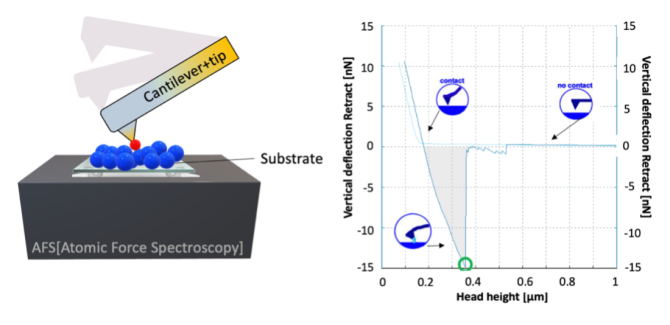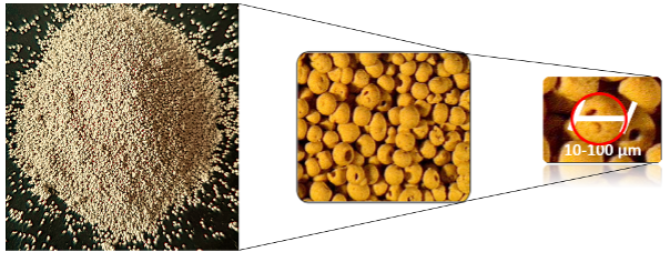News
Atomic force microscopy (AFM)-Rheometry: How adhesive particle properties affect their collective flow behavior
Introduction Over the past 20 years Atomic Force Microscopy (AFM) have emerged as an essential material characterization technique in various fields. With an AFM, a large range of topographies (atomic terraces, carbon nanotubes, colloidal particles, viruses, fractured surfaces, and complex multi-phase polymers) and many types of materials can be imaged. In general, the AFM studies can be divided into topographical applications (imaging mode) and force spectroscopy or so-called atomic force spectroscopy (AFS), i.e., measuring forces as a function of distance. The AFM generates an image of the sample surface to observe its structural or dynamic features and it has been employed very effectively on a wide variety of surfaces, including biological systems and polymers, with resolution in the micrometer to subnanometer range, thus facilitating imaging at the submolecular level. The second group (AFS) is one of the most promising and interesting research areas, allowing the study of inter- and intra-molecular forces. AFS has already been successfully applied to studies of biological systems, polymers, mineral surfaces and interfacial phenomena. Therefore, with AFS we can look into the interaction forces between two particles or particle-surface. This could be in air (van der waals, capillary forces (in presence of humidity)) or even in water. Based on the particles and surfaces in both conditions, we can check for the adhesion forces by looking at the force-distance curves obtained from AFS (figure 1). Many studies have shown the applicability of the AFS for a well-defined surface, such as silica and mica; however, what happens if we go to more complex surfaces where the surface is made of different minerals and might show more interesting force response.

Figure 1. How Atomic Force Spectroscopy works: (a) cantilever is functionalized with a particle, makes a contact with a surface of particles. (b) result of AFS tests is a force-distance curve where you can obtain the pull-off forces.
Ceramic powders (figure 2) (base materials for porcelain stoneware) could be one of those complex particles that might show interesting force behavior. Ceramic powders are interesting to study from several aspects: (1) they are sticky at certain conditions that can be quantified using AFS, and (2) studying their adhesion response might be useful for ceramic industry where they care about the adhesive properties of such powders. For studying the industrial ceramic powders one needs to check what parameters control or affect the interaction between particles,
such as humidity, pH, etc. The interesting behavior of the ceramic particles will help us to compare how their adhesive properties affect flow behavior and use this feature for further applications in the ceramic industry.

Figure 2. Ceramic microparticles. Several length scales are indicated.
Aim of the project
In this project you will perform experiments to find out the adhesion mechanism between ceramic-silica surfaces. We expect you to conduct experiments on micro-level using AFM and in macro-level using rheometer. With micro-level data (particle-particle) we will understand how adhesion forces at the contact level can be measured. However, we also need to know whether particles in the bulk behave in the same way as in the micro-level. Here you will work on studying flow behavior of particles using rheometer.
You will be involved in preparation methods of functionalizing cantilever tips, surfaces, ceramic suspensions if required. We will train you on how to use AFM and rheometer.
Afterwards, you will use your know-how approach to quantify and explain the nature of the contact forces between ceramic-silica surface. At the end of this project based on your findings, you will be able to answer if adhesive characteristics of particles also affect the rheology of particle suspensions. Based on your preference, you can be involved in modelling of contact forces between particles.
Methods/Techniques to be used
- Atomic Force Microscope and Spectroscope (AFM & AFS)
- Rheometer
- Humidifier
- Matlab/JPK processing software
The overall project consists of a collaboration between the laboratory of physical chemistry and soft matter (PCC) and SACMI company (Imola, Italy [https://www.sacmi.com]). This thesis proposal is an opportunity for a student to work on an existing research project going on in our lab and have a 5-6 month of internship in SACMI company where you can be more involved in a real-life experience of how ceramic industry works. Do not hesitate to contact if you want to know more about the project or want to do a visit.
Contact person
Please write to Zohreh Farmani and Joshua Dijksman for further questions.